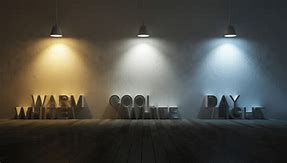The advent of both fluorescent and LED lighting presents us with given a ‘choices’ of what kind of colour of light we prefer… white; warm white; cool white or daylight white – but what are the differences in these ‘colours’ and what impact does it have on our lives?
The ‘white’ of a light and therefore its colour is measured in Kelvins. The Kelvin scale is a thermodynamic temperature scale and its use dates back to the stages of heating carbon and seeing temperature and colour change and colour change as it got hotter – we’ve all heard of ‘red hot’ or ‘white hot’ and this is essentially how we measure light and is reflected in the time of the day that any white light mirrors.
See the table (Colour Temperatures in the Kelvin Scale) to illustrate the changes in colour that occur as the heat increases and, therefore, the number of Kelvins increases accordingly:
In the field of lighting, the higher the number of Kelvins the ‘cooler’ the white appears and the ‘bluer’ the content of the white light contains, thus creating more of a cool white.
Conversely, the lower the number of Kelvins, the white light contains more yellow, creating a warmer white.
The common colour temperatures found in both traditional and modern lighting are detailed below;
- 2700k – Very Warm White
- 3000k – Warm White
- 4000k – Cool White
- 6500k – Daylight

The Psychology behind the colour temperature and your business Lighting

So, which White is best to use in which area?
Lighting is a very subjective topic, as we all have our own perspective and opinion on what we want from our lighting. However, numerous studies have been undertaken as to how we react, physically and mentally, under certain colour temperatures.
Relatively recently, a third receptor was discovered in the eye (in addition to rods and cones) which links to the brain and we see the light in a more sensory way, and is also responsible for our circadian rhythm (our body clock) and therefore prompts our bodies to react in certain ways;
Cool white – reflects early morning and therefore we tend to concentrate more and have more energy.
Warm White – reflects late afternoon when we are starting to wind down for the day and have a calmer feel.
Very warm white – this mirrors sunset when we are relaxed and winding down for the day.
In lighting designs, the feelings evoked by the memory of the sun’s

We have all experienced environments where we do not feel comfortable or that something “just isn’t right” – in the vast majority of occasions this is due to the incorrect lighting being used.
Some good examples of this would be;
Gym lighting – here the aim is for the members to feel energetic and get the most out of their sessions, so we want to feel energetic and, therefore, the lighting tends to be cool white to give the feel of early morning when we have the most energy.
Pub lighting – here we want the customer to feel relaxed and stay, enjoy the atmosphere and, of course, spend more money, so a warmer feel to the lighting would be used.
Choosing the right light can have a direct impact on the turnover and profit of a business, just as much as getting the lighting wrong can kill the atmosphere and turn customers away!
An anecdotal extreme example of the business impact could be – a fast food restaurant, with the following lighting;
At the counter – warm white lighting is used to give a friendly, warm, relaxed feel to the area – so when customers are placing their order, they are more open to upsell techniques.
Over the plastic chairs a cool white light is used so you eat your food quickly so you move on and free the space for the next customer.
Here’s a handy quick guide to where

If you require any further information or support please do not hesitate to contact us.
